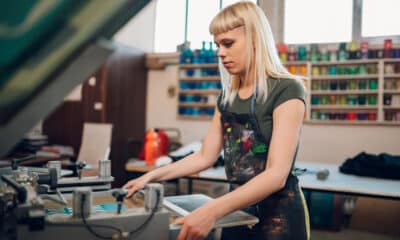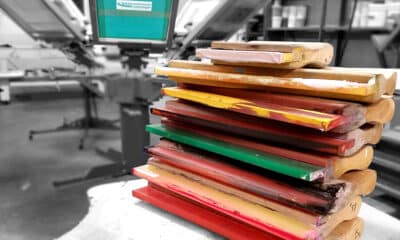IN THE WORLD OF GARMENT decoration, appliqué — a technique that involves sewing a piece of fabric onto a base garment to create intricate designs — has stood the test of time. It combines artistry with functionality, allowing brands to express their identity in unique and visually striking ways. There is no substitute for traditional appliqué. This traditional technique requires specialized equipment and skilled labor, typically reserved for premium products that command higher prices. However, to meet today’s consumer demands for fast turnaround and fair pricing, there is an opportunity to provide additional options.
Enter heat-applied appliqué, an innovative solution that preserves the high-quality look of traditional methods while streamlining execution and expanding possibilities.

3 Laser-cutting equipment is needed for processing twill material into appliqué pieces in preparation for sewing.
The Traditional Appliqué Process
To understand the new opportunity, it’s helpful to understand the traditional execution and limitations. In a traditional appliqué process, the creation of a completed garment is somewhat complex and labor-intensive. It typically involves the following steps:
- Fabric Cutting: Multiple layers of fabric (such as twill or felt) are cut to the desired shape or design. Usually this involves a detailed manual or machine cutting process to ensure precision. Flatbed knife cutting equipment or laser cutting equipment are options to complete this step of the process.
- Creating a Sew File: A sew file is created on a computer, which includes all the stitching details, including the outline, placement stitch, and finishing stitches for the appliqué.
- Hooping the Garment: The garment (such as a jersey or sweatshirt) is then hooped tightly to ensure it remains stable during the stitching process. This often requires a stabilizer backing, which will be removed later in the process after sewing.
- Sewing the Placement Stitch: A placement stitch is sewn on the garment, which serves as a guide for where the appliqué will be placed by an operator.
- Placing the Appliqué: The fabric appliqué is then placed on the garment, precisely over the placement stitch.
- Completing the Sewing: Finally, the sewing machine completes the design by adding finishing stitches that secure the appliqué and give the design a polished look. The operator then removes the hoop, cleans the applique by snipping any excess thread and tears away the stabilizer backing to complete the garment.
Heat-Applied Appliqué: A New Opp
Heat-applied appliqué is much like traditional appliqué, except the fabric is constructed into a ready-to-heat press appliqué. It is created from real fabric, often contains real thread, and can be produced on the same machines that traditional appliqué is produced on. The main difference between heat-applied appliqué and traditional sewn appliqué is the affixation to the garment.
Traditional appliqué is sewn into the garment, resulting in thread being present on the inside of the garment, whereas heat-applied appliqué is affixed with a heat press. The advancement of fabrics, adhesives, heat presses, and processing equipment are making this decorating technique nearly indistinguishable from traditional appliqué from the outside of the garment.
With this in mind, let’s explore the advantages, use cases, and styles of heat-applied appliqué.
Advertisement

Businesses can stock heat-applied appliqué materials and produce items to order, allowing for quicker replenishment of inventory without committing to a large stock of decorated items.
The Advantages
- Ease of Use: Products like Sport-Stitch arrive ready to position and heat press, eliminating the need for complicated setups. Made with real sewing and actual thread, it offers a professional finish that closely resembles traditional sewn appliqué — without the interior stitching and stabilizer backing.
- Material Versatility: Heat-applied appliqué can be crafted from various materials, including polyester tackle twill, acrylic felt, dazzle cloth, and more. This versatility allows brands to customize their offerings and create eye-catching designs suitable for any application. It’s also ideal for more applying to textured materials like fleece, giving a unique finish to products such as hoodies, jackets, and blankets. When coupled with a heat press that includes lower as well as top heat, heat-applied appliqué can be used on performance hoodies and other heat-sensitive fabrics like jerseys.
- On-Demand Production: Businesses can stock heat-applied appliqué materials and produce items to order, allowing for quicker replenishment of inventory without committing to a large stock of decorated items. This is especially advantageous for retailers, where the ability to refresh offerings and react to consumer preference quickly significantly can boost sales without incurring hefty costs.
- Lower Equipment Investment: With heat-applied options, brands no longer need to invest in fabric cutting or embroidery equipment. This lowers the barrier to entry for companies wanting to deliver high-quality appliqué results while maintaining operational efficiency.

Sport-Stitch heat-applied appliqué combines twill (orange layer) and acrylic felt (cream layer). It arrives ready to heat-press.
A Matter of Speed
One of the greatest advantages of heat-applied appliqué over other methods like direct embroidery is efficiency — especially for larger designs. Direct embroidery, while effective, can use a lot of machine time, especially for large designs. This limits the output of pieces-per-hour or shift.
In contrast, appliqué is much faster. It simplifies the process by allowing decorators to reduce stitch count by shifting larger fill areas to pre-made appliqué materials (like twill or felt).
Maximum Efficiency
With just a heat press, decorators can execute a garment every one to two minutes, making it the most efficient apparel decorating method. This makes heat-applied appliqué perfect for high-volume, on-demand environments, such as at events or in retail locations where quick turnaround is key. No need for heavy machinery or large footprint production setups. All you need is a heat press, and the result is a clean, polished look in record time.
The Importance of Quality Equipment
To succeed with heat-applied appliqué, the quality of your heat press equipment is crucial. For optimal results, a heat press with both top and bottom heat is recommended. This ensures even pressure and heat distribution, which is essential for achieving professional, durable results.
For retailers looking to offer more customized personalization options — especially for fan merchandise and NIL (Name, Image, Likeness) products — investing in projection technology can further elevate the customer experience. Projecting the placement of letters and numbers onto the garment allows for precise customization, even from a novice operator.

3 Heat-applied appliqué can be crafted from various materials. This versatility allows brands to customize their offerings and create eye-catching designs.
Sports and Retail Market Applications
Heat-applied appliqué has found one of its niches in the licensed jersey decoration business, particularly for sports numbering and lettering on fan jerseys. This ready-to-heat method enables teams and retailers to offer customizable options and personalization without extensive inventory management. Being able to react quickly to demand has allowed retailers to control committed inventory and support a wide range of players, as well as personalization.
NIL Personalization is Key
One of the most significant recent developments in the sports retail market is the introduction of Name, Image, and Likeness (NIL) rights for athletes. This has opened up new opportunities for personalized fan merchandise, especially jerseys and apparel, where fans can support their favorite athletes by purchasing custom gear. Heat-applied appliqué plays a crucial role in this personalization process, allowing retailers to quickly and cost-effectively create custom jerseys featuring individual athlete names and numbers. Retailers can stock blank jerseys and personalize them in real-time using heat-applied appliqué. This meets the growing demand for NIL-based customization without the need for large inventories.
Advertisement


 Expert Perspectives2 months ago
Expert Perspectives2 months ago
 Women in Screen Printing1 month ago
Women in Screen Printing1 month ago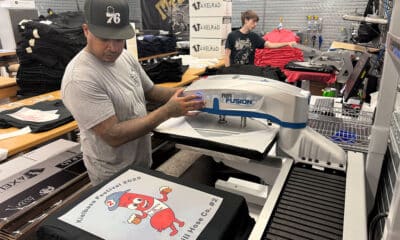
 Shop Management2 months ago
Shop Management2 months ago
 Women in Screen Printing1 month ago
Women in Screen Printing1 month ago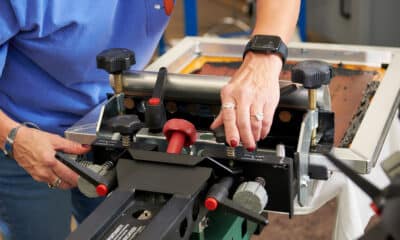
 Case Studies3 weeks ago
Case Studies3 weeks ago
 Kevin Baumgart2 months ago
Kevin Baumgart2 months ago
 Thomas Trimingham4 weeks ago
Thomas Trimingham4 weeks ago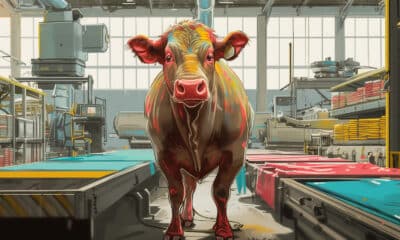
 Marshall Atkinson1 month ago
Marshall Atkinson1 month ago




